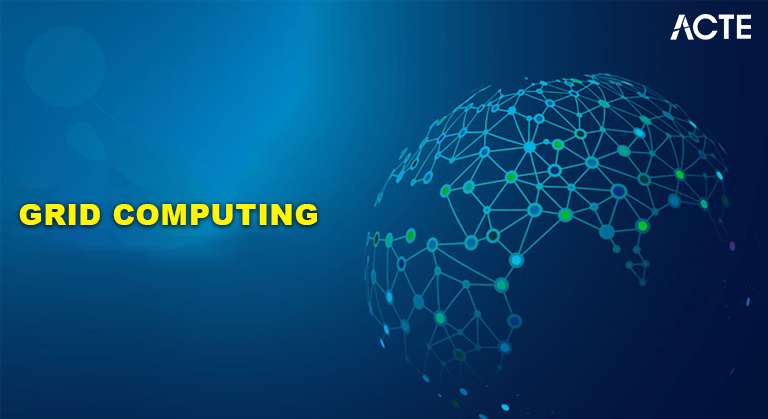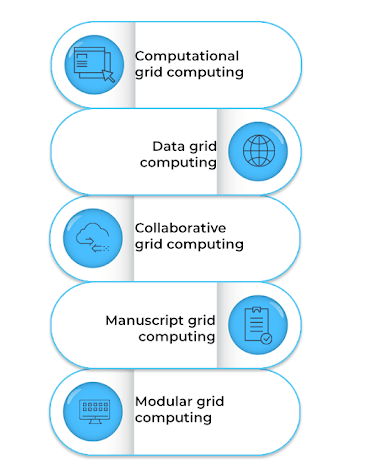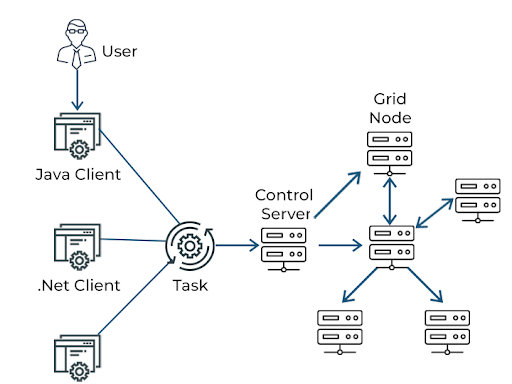
- Overview of Grid Computing
- Different Grid Computing Types and Their Functions
- Important Elements of Grid Computing
- Use Cases and Real-World Applications of Grid Computing
- Prominent Grid Computing Examples
- Advantages of Grid Computing
- Drawbacks of Grid Computing
- Conclusion
Overview of Grid Computing
A distributed computing paradigm known as “grid computing” links several computers, or “nodes,” to function as a single, cohesive system while sharing resources and processing capacity. Grid computing makes it possible to analyze data and do complicated activities that would be difficult for individual systems to perform on their own by combining multiple devices into a network. Cloud Computing Course can be used to tackle complex issues requiring a lot of processing power in a variety of domains, including business, healthcare, and scientific research. Computational grids, data grids, and virtualized grids are among the several forms of grid computing, each with a distinct function. Tasks are broken down into smaller subtasks in a typical grid computing system, and these subtasks are then allocated to various machines for execution. This enables quick processing times and effective resource use. Grid middleware (software that controls job distribution), resource management systems, and the hardware network that connects all of the machines are essential elements of grid computing. Complex modeling, data analysis, and simulations are among the fields that frequently use grid computing. Grid computing has drawbacks with regard to security, dependability, and network congestion, despite its many benefits, including cost effectiveness and flexibility. Notwithstanding these difficulties, grid computing is still an essential tool for solving issues requiring large amounts of processing power and is always changing to satisfy the increasing demands of contemporary technology.
Different Grid Computing Types and Their Functions
There are various types of grid computing, each intended to meet particular processing requirements to Guide to AWS SSO. The primary types and their purposes are as follows:
- Computational Grids: The main goal of these grids is to supply computational power by dividing up processing duties across several computers. They are perfect for engineering models, scientific simulations, and any other work that involves a lot of computation. Computational grids have the potential to greatly accelerate difficult calculations by utilizing idle computing resources.
- Data Grids: Large volumes of data across dispersed systems can be managed and stored using data grids. They are essential for applications involving big datasets, such as weather forecasting, genomics, and medical research, since they make high-performance data retrieval and storage possible. Data grids guarantee effective data access, replication, and sharing across several sites.
- Collaborative Grids: By enabling users to access and share resources via a network, these grids emphasize fostering collaborative work. They are frequently used to support collaborative initiatives in research and education, allowing team members to collaborate remotely on shared datasets or computational tasks.
Unlock your potential in Cloud Computing with this Cloud Computing Online Course .
- Virtualized Grids: Better resource allocation and administration are made possible by virtualized grids, which combine grid computing and virtualization technology. Virtualized grids are ideal for Cloud Computing Models Types Benefits and Examples and enterprise resource management because they maximize hardware utilization while providing flexibility and scalability. Every kind of grid computing has a distinct purpose, assisting companies, scholars, and sectors in enhancing data accessibility, maximizing computational efficiency, and promoting cooperation.

Important Elements of Grid Computing
In order to provide strong, distributed computing solutions, grid computing depends on a number of essential components.
- Grid Middleware: In a grid, this is the software layer that links several computers or resources. It manages resource allocation, job scheduling, task distribution, and node-to-node communication, guaranteeing smooth coordination and effective work completion.
- Resource Management Systems: Grid resources including processing power, storage, and network bandwidth are managed and distributed by these systems. They balance workloads, keep an eye on availability, and guarantee that resources are used as efficiently as possible throughout the grid.
- Grid Nodes: These are the separate computers or devices that comprise the grid. In addition to providing processing power, storage, or other resources, each node in the grid can execute commands, store information, or serve as a communication channel.
- Communication Infrastructure: The seamless transfer of information and commands between grid nodes depends on a strong network architecture. This covers secure data transfer technologies, fast internet connections, reliable protocols, and efficient routing mechanisms to ensure optimal data flow and performance across the grid.
- Security Frameworks: Because grid computing is distributed, it is essential to make sure that resources, data, and connections are secure. Security frameworks manage encryption, permission, and authentication to safeguard private data and stop illegal access.
Gain in-depth knowledge of Cloud Computing by joining this Cloud Computing Online Course now.
Use Cases and Real-World Applications of Grid Computing
Scientific Research Grid computing is widely used to do complex calculations, manage large databases, and execute simulations in fields like biology, chemistry and physics. Examples include climate modeling and particle physics at the Large Hadron Collider (LHC). Healthcare and Genomics Cloud Computing Course helps researchers with genetic data processing, medical imaging system creation and drug discovery simulations. Grid computing allows for faster processing of large-scale genetic research. Weather Forecasting Meteorological institutions employ grid computing to process massive volumes of data for weather forecasting, climate modeling and catastrophe management, increasing the timeliness and accuracy of forecasts. Financial Services Grid computing assists the financial sector with advanced risk analysis, fraud detection and real-time financial modeling by processing enormous volumes of data from markets and transactions. Engineering and Manufacturing Grid computing facilitates product design, simulations and testing. Engineers can use grids to develop prototypes, perform stress testing, and refine designs without requiring a lot of physical resources. Entertainment and Media it is used in 3D graphic rendering, animation, and video creation. Large media companies employ grid computing to handle computationally intensive tasks like producing computer-generated imagery (CGI) in movies. Education and Collaborative Projects Grid computing facilitates cooperative research projects, remote learning, and resource sharing, which aids academic institutions, research centers, and students in working together on global-scale projects.

Prominent Grid Computing Examples
- SETI@home: In an effort to find extraterrestrial life, Cloud Technologies research analyzes radio signals from space using grid computing. To assist in processing enormous volumes of data, volunteers from all over the world provide the idle processing power of their computers.
- The Large Hadron Collider (LHC): The massive amounts of data produced by particle collisions are processed by the LHC using grid computing. In order to assess results and further particle physics research, the grid links thousands of computers across the globe.
- Einstein@home: Like SETI@home, this project analyzes vast data to find gravitational waves using grid computing. Large volumes of data from radio telescopes are processed on computers owned by volunteers, contributing valuable computational power and helping advance scientific discoveries in astrophysics.
- Weather Forecasting: Grid computing, which processes massive real-time information from satellites, radar, and sensors, is essential to weather prediction. It is used by meteorological organizations for precise climate modeling, accurate predictions, and advanced forecasting techniques.
- Genomics and Drug Discovery: In the fields of biotechnology and pharmaceuticals, grid computing allows researchers to simulate molecular structures and analyze enormous volumes of genetic data. It expedites genetic sequencing and drug discovery procedures.
- Global Learning and Education Platforms: Grid computing is used by research organizations and educational institutions to work together on tasks that need a lot of computer power, like data processing, simulations, and resource sharing for studies.
Take charge of your Cloud Computing career by enrolling in ACTE’s Cloud Computing Master Program Training Course today!
Advantages of Grid Computing
Cost Efficiency Grid computing reduces the need for new infrastructure and operating expenses by making use of already-existing resources, such as idle processing power from distributed systems. Scalability Without requiring major modifications to the system’s architecture, grid systems can readily grow by adding more nodes or resources to accommodate increasing computational needs. Resource Sharing it maximizes resource use and boosts productivity by enabling enterprises to share data, storage, and processing power across several sites. High Performance breaking up large, complex processes into smaller, parallel-processing jobs, grid computing can process them more quickly and produce speedier results. Flexibility Grid computing is flexible to various industries and use cases since it enables a broad range of applications, from corporate operations to research simulations. Fault Tolerance Grid computing provides dependability and robustness with dispersed resources. Cyber Extortion may reroute tasks to other accessible nodes in the event of a node failure, guaranteeing continuous operation. Collaboration making it possible for several institutions, academics, and organizations to use and share computer resources for collaborative projects, it promotes cooperation. Efficient Data Processing Grid computing, which uses a network of computers, makes it possible to handle and process massive datasets efficiently, particularly in areas like environmental monitoring, healthcare, and genetics.
Are you getting ready for your Cloud Computing interview? Check out our blog on Cloud Computing Interview Questions and Answers!
Drawbacks of Grid Computing
- Security Concerns: Grid computing is susceptible to cyberattacks and illegal access because it contains numerous dispersed nodes, making it difficult to ensure secure communication and data privacy.
- Complex Setup and Maintenance: Because grid computing systems integrate several resources, networks, and software components across multiple locations, they can be complicated to set up and manage.
- Network Dependency: Data transport between nodes in grid computing is largely dependent on the network architecture. The performance of the system might be greatly impacted by high latency or poor network connectivity.
- Resource Management Challenges:Effectively managing dispersed resources can be challenging, especially when there is an imbalance in load distribution, resource conflicts, or a lack of synchronization.
- Limited Compatibility: Compatibility problems resulting from disparate grid nodes’ usage of different hardware or software might impede smooth operation and necessitate extra configuration or standardization.
- Reliability Issues: The performance of the entire system may be impacted by the failure of a single node or resource since grid computing uses numerous dispersed machines, while fault tolerance techniques in Master Docker Entrypoint.
- High Power Consumption: Grid computing can lead to excessive energy consumption, which can raise operating expenses and have an adverse effect on the environment, particularly when utilizing a large number of nodes.
- Management Overhead: Large-scale grid system coordination and management can be very administratively taxing, particularly when dealing with several institutions or organizations.
Conclusion
Multitenancy has revolutionized the way software applications are delivered, particularly in cloud-based environments. By allowing multiple tenants to share the same software instance while maintaining data isolation, customization, and scalability, businesses can optimize resources, reduce costs, and deliver high-quality services to a broader audience. However, Cloud Computing Course also requires careful consideration of security, performance, and customization aspects. With the right architecture, strategies, and best practices, multitenancy can provide significant benefits to both software providers and their clients across industries. Moreover, multitenancy enables software providers to offer more flexible pricing models, such as subscription-based or tiered pricing, allowing customers to choose the level of service that best suits their needs. This flexibility enhances customer satisfaction and makes services more accessible to a diverse range of businesses, from small startups to large enterprises. Additionally, multitenant architectures support faster onboarding for new customers, enabling them to quickly integrate with the platform without extensive setup processes. As organizations continue to adopt cloud technologies, the role of multitenancy in driving operational efficiency and business growth becomes increasingly critical. By embracing multitenancy, companies can stay competitive while providing exceptional services to a growing customer base.





